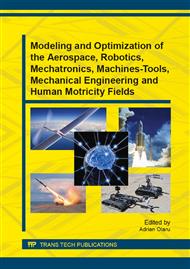[1]
J. Craig, Introduction to robotics, Reading, MA: Addison-Wesley, (1989).
Google Scholar
[2]
J. Angeles, Fundamentals of Robotic Mechanical Systems: Theory, Methods, and Algorithms, 3rd Edition, Springer‐Verlag, New York, (2006).
Google Scholar
[3]
G. Antonelli, G. Indiveri and S. Chiaverini, Prioritized closed loop inverse kinematic algorithms for redundant robotic systems with velocity saturations, Proceedings of IEEE/RSJ Int. Conf. on Intelligent Robots and Systems, 5892–5897, St. Louis, USA, Oct (2009).
DOI: 10.1109/iros.2009.5354636
Google Scholar
[4]
D. Howerd, Application of Fuzzy Logic for the Solution of Inverse Kinematics and Hierarchical Controls of Robotic Manipulators, Journal of Intelligent and Robotic Systems 23: 217–247, (1998).
Google Scholar
[5]
C. Klein, C. H. Hung, Review of pseudoinverse control for use with kinematically redundant manipulators, IEEE Trans. on Systems, Man, and Cybernetics, Vol. 13, 245–250.
DOI: 10.1109/tsmc.1983.6313123
Google Scholar
[6]
B. Siciliano and G. Bastin, Theory of Robot Control, Springer Verlag, London, U.K., (1996).
Google Scholar
[7]
L. Sciavicco and B. Siciliano, A solution algorithm to the inverse kinematic problem for redundant manipulators, IEEE J. of Robotics and Automation, Vol. 4, No. 4, 303–310, (1998).
DOI: 10.1109/robot.1987.1087921
Google Scholar
[8]
C. Carignan, Trajectory optimization for kinematically redundant arms, Journal of Robotic Systems, Vol. 6, No. 5, 221–248, (1993).
DOI: 10.1002/rob.4620080206
Google Scholar
[9]
T. Deepak, Real-Time Inverse Kinematics of the Human Arm, Presence. Vol. 5. No. 4., 393-401 by the Massachusetts Institute of Technology, (1996).
Google Scholar
[10]
MathWorks Suport-Fuzzy Logic, http: /www. mathworks. com/help/html.
Google Scholar


